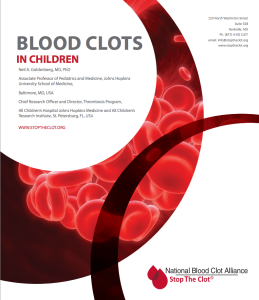What causes DVT/PE in children?
Definitions:
Genetic thrombophilia: Inherited clotting conditions that can increase your child’s tendency to form blood clots.
Acute: Sudden or short-term.
Chronic: Long-term.
The following health issues can cause (or add to the risk of developing) DVT/PE in children:
- Poor blood flow in the veins. This may happen when children are confined to bed in the hospital. It can also occur in rare conditions where there is abnormal narrowing of a vein, including the iliac vein of the left leg (May-Thurner syndrome) or in the subclavian vein, near where the arm meets the chest (Paget-Schoetter syndrome, also known as venous thoracic outlet syndrome, or vTOS).
- Damage to the inner lining of veins. This can happen when a “central line” catheter, such as a “port” or “PICC,” are inserted into a major vein. These long, flexible tubes are used when certain medications or fluids need to be given by vein, but a standard IV catheter is not possible. It may also happen when certain medications, such as some chemotherapy (or “chemo” drugs) are given.
- Inherited clotting conditions (also known as “genetic thrombophilias”). One of the most common inherited conditions that increase the risk of DVT/PE is called factor V Leiden. This change in the gene for clotting factor V is present in approximately 5% of people who describe themselves as being Caucasian. When a person has factor V Leiden for one of their two copies (called “heterozygous”) for the factor V gene, it increases the risk of developing DVT/PE by about five times.
- Other illnesses and certain medications. A variety of recent or ongoing illnesses, such as severe infections, can activate the clotting system and make the blood more likely to form clots in the veins. Birth control pills, patches, or rings that contain estrogen also increase the risk of DVT/PE, especially in patients who have a family history of DVT/PE that occurred at a young age (for example, before 50 years old) of who have other risk factors for developing blood clots (especially factor V Leiden).
In most children with blood clots, more than one risk factor is involved. Less commonly, the causes of a child’s blood clot may remain unknown even after a thorough evaluation.
Neil A. Goldenberg, MD, PhD
Professor of Pediatrics and Medicine, Johns Hopkins University School of Medicine,
Baltimore, MD, USA
Founding Director, Pediatric Thrombosis & Stroke Programs
Johns Hopkins All Children’s Hospital
St. Petersburg, FL, USA
Updated: September 2024





